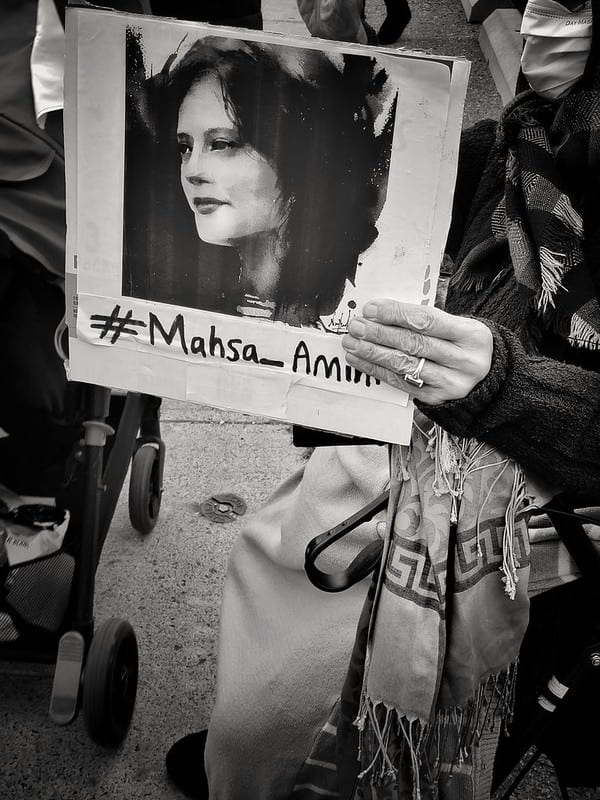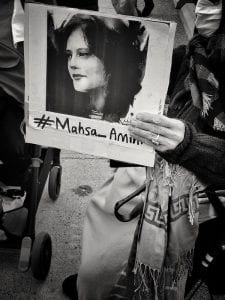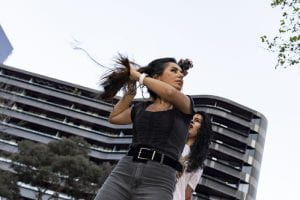September 14th, 2024, marked two years since the murder of 22-year-old Mahsa Amini in Iran’s capital, Tehran. Amini was arrested by the “Gasht-e-Ershad,” also known as the morality police, who are responsible for enforcing Iran’s strict dress code. For women, this includes a head covering called a hijab and loose-fitting clothes.
Authorities claimed that Amini had worn her hijab “improperly” and transported her to a detention center for a “re-education class.” Amini collapsed at the center later that evening and died three days later while in police custody.
Government officials claimed her cause of death was a heart attack. However, her family denied that she had any history of heart issues, and they were refused the chance to see her body before she was buried. Witnesses from the day of her arrest alleged that Amini was severely beaten in the patrol van—photographs and videos of Amini in the hospital corroborate this, indicating trauma to her head.
It’s unclear how she died, but it certainly wasn’t from a heart attack. Rather, Mahsa Amini was a victim of an oppressive regime that sought to tyrannize women in the name of religion.

Nationwide Response and Iran’s Crackdown
Amini’s murder at the hands of the morality police caused international outrage and political unrest, a catalyst for the biggest uprising that Iran has seen since the 1979 Islamic Revolution. These protests were primarily led by women, a fiery rejection of a government that restricts the freedom of its citizens and meets resistance with violence.
Security forces used excessive or lethal force in response to demonstrations that were oftentimes peaceful, firing into crowds with rubber pellets or automatic weapons and beating protestors. As of September 15th, 2023, at least 551 were killed, and around 19,000 were arrested in relation to the uprising. Authorities also heavily restricted Internet access to prevent the spread of information and protest videos, as well as disrupt the rights to freedom of expression and peaceful assembly.
Iran’s pushback against widespread public dissent includes the Hijab and Chastity law, proposed by deceased former president Ebrahim Raeesi in May 2023. This was officially approved by the Guardian Council in September 2024 and will be enforced on a trial basis for three years.
The law tightens the mandatory dress code, with penalties of up to 10-15 years in prison, depending on the frequency of violations. It also directly responds to online defiance by punishing influencers or public figures who promote or share content that disparages the dress code, with internet restrictions, fines, and even being banned from leaving Iran. Article 28 calls for law enforcement agencies to use online monitoring systems to report violators to the judiciary.
In July 2023, it was announced that, after a brief recess caused by the protests, the morality police would begin patrolling the streets again to monitor civilians who “ignore the consequences of not wearing the proper hijab and insist on disobeying the norms.”
The government has also used traffic cameras to detect and subsequently fine women without hijabs, detained and suspended female university students who have violated the law, and forcefully shut down businesses that serve women with the “improper dress code.”
Despite these endless threats, Iranian women and girls refuse to be deterred. They continue fighting for their freedom and their right to dress as they wish, even when it might cost them their lives. A 40-year-old woman from Tehran told The Washington Post, “Us Iranian women have gotten to a point where it’s either death or freedom for us. We will pay any price, but we won’t go back to what life was before” the uprising.
Below are the stories of just some of the women and girls who are symbols of the resistance against their oppression and deserve to be remembered.
Roya Heshmati
Roya Heshmati, a 33-year-old woman who lives in Tehran, posted a photo of herself on social media. The photo in question shows Heshmati with her back to the camera, wearing a red shirt, long black skirt, and no head covering. Late at night on April 20th, 2023, authorities arrested Heshmati in her home and confiscated her phone and laptop. She spent 11 days in detention on the charge of “appearing in public without proper religious hijab” and was initially sentenced to 13 years and 9 months in prison, a fine of 12,500,000 rials ($297), and 74 lashes.
Mizan, Iran’s Judiciary News Agency, wrote that Heshmati’s sentence was carried out “in accordance with the law” while also accusing her of “promoting prostitution” and receiving money from abroad. Her actions were described as “injuring public modesty” and “encouraging people to commit corruption.

An appeal overturned the prison sentence and reduced the fine, but the lashes remained, alongside a three-year ban from leaving Iran. On January 3rd, 2024, Heshmati refused to wear the hijab while receiving her lashes in court, which she compared to a “medieval torture chamber.”
Roya’s story sparked support across social media, both within and outside of Iran, for her courage in the face of a barbaric punishment and blatant attacks on her character.
Arezoo Badri
On July 22nd, 2024, 31-year-old Arezoo Badri was driving home with her sister in the city of Noor. Police tried to pull Badri over to confiscate her car—this was most likely a result of a new surveillance measure to identify and confiscate the vehicles of female drivers or passengers traveling without head coverings.
It is not confirmed whether Badri directly violated this rule, but the confiscation notice associated with her car suggested that she had. She did not stop when prompted by police, at which point they began shooting, first at her tire before aiming at the driver’s side. The bullet reportedly entered her lung and caused severe damage to her spinal cord. It was not removed until 10 days later. Badri underwent lung surgery and was later transferred to a hospital in Tehran, where she stayed under tight security.

A physician in Tehran told The Guardian in August, “We have had no news on her condition because it’s a heavily guarded military hospital and owned by the police.” Most recent updates on Badri’s state indicate that she is paralyzed from the waist down, but it is unknown whether she will be permanently paraplegic.
Iran International reported that authorities coerced Badri to confess, a tactic repeatedly used as a means to “control the narrative and suppress opposition.” In the video, Badri can supposedly be seen crying due to her critical condition. Her family members (including her sister, who was in the car) were forced to confess as well, on top of having restricted access to visit Badri throughout her time in the hospital.
Confessions like these are broadcast through state media as an attempt to justify and cover up instances of abuse, but human rights organizations like Amnesty International have taken notice of the brutalization against Arezoo Badri and are calling for Iran to stop the state-sponsored violence against women.
Armita Geravand
On October 1st, 2023, 17-year-old Armita Geravand was boarding a train in Tehran when she collapsed and fell into a coma. She died weeks later, on October 28th, suffering brain damage after receiving intensive medical care. Witnesses claim that Geravand was attacked by a hijab enforcer upon entering the train, but authorities assert that she fainted, allegedly having “hit the back of her head against the edge of the platform.”
Surveillance cameras are present inside the series subway car that she boarded. However, Iranian authorities have only released footage from the station, where Geravand can be seen getting on the train without a headscarf, followed by her friends. Just moments later, her friends carry an unconscious Geravand out. Video analysis by Amnesty International’s Evidence Lab concluded that the footage: “Based on the footage time stamps, three minutes and 16 seconds of the metro footage are missing.”

In the immediate aftermath, authorities reportedly arrested a journalist investigating the incident. Fajr Hospital, where Geravand was being treated, was heavily guarded. State media also spread videos of Geravand’s family affirming what authorities claimed about her collapse due to low blood pressure. Human rights groups like Hengaw have called for independent investigations into her death, but such concerns have been dismissed by security forces.
Armita Geravand’s killing is a horrifying mirror of what happened to Mahsa Amini, garnering further international scrutiny upon the Iranian government for yet another suspicious death under their custody.
The Acts of Defiance Continue
Mahsa Amini’s murder undoubtedly turned a tide in Iran—as the second anniversary of her death passed, women continue to assert their bodily autonomy in the face of ruthless measures that try to strip it away. Whether that’s by participating in large-scale protests or through small acts of defiance, Iranian women and girls will fight until they are free.




